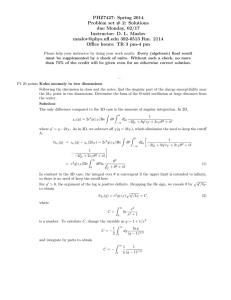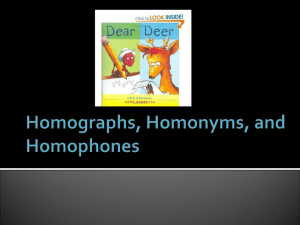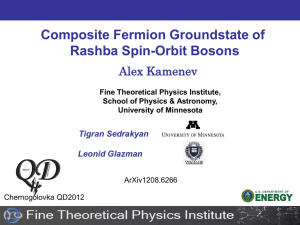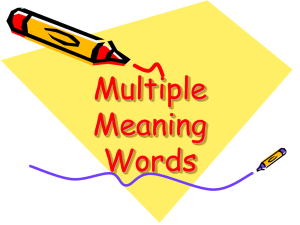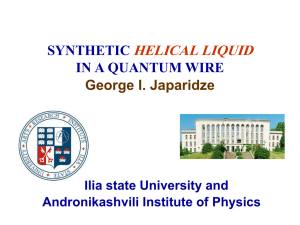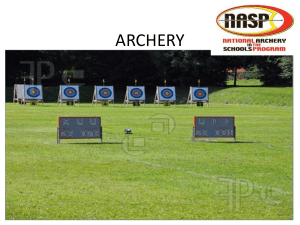Jean-Paul Pouget. Charge ordering in quasi
advertisement
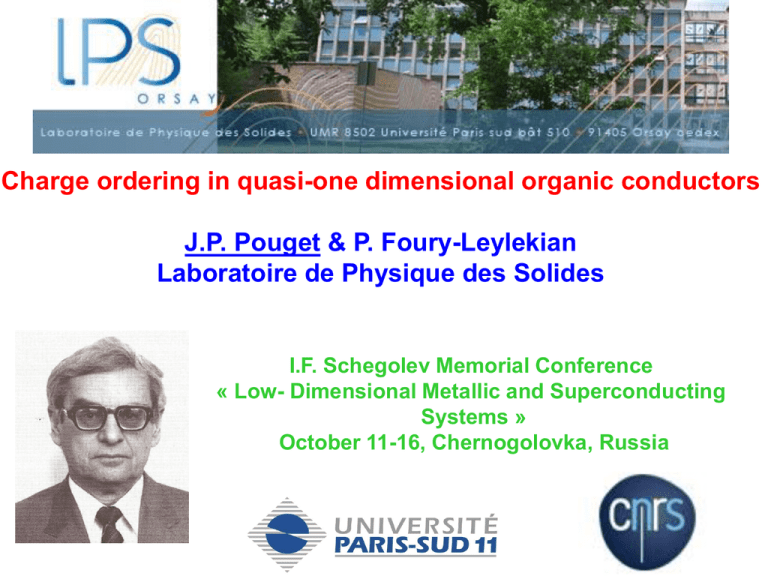
Charge ordering in quasi-one dimensional organic conductors J.P. Pouget & P. Foury-Leylekian Laboratoire de Physique des Solides I.F. Schegolev Memorial Conference « Low- Dimensional Metallic and Superconducting Systems » October 11-16, Chernogolovka, Russia outline • Focus on organic conductors experiencing important electron-electron interactions • Charge density wave (CDW) electronic instability and its coupling with the lattice • In particular: 4kF CDW instability in 1D / Charge ordering (CO) / Wigner localization • In 2:1 salts: influence of the anion sublattice ORGANIC CHARGE TRANSFER SALTS 1D Donor A 2 bands crossing at EF 2kF(A)= 2kF(D) Only a single 2kF D critical wave vector! Acceptor Charge transfer ρ (generally incommensurate): D+ρ A-ρ 2kF=ρ/2 PEIERLS’ CHAIN 1D metal coupled to the lattice: unstable at 0°K towards a Periodic Lattice Distortion which provides a new (2kF)-1 lattice periodicity 2kF PLD opens a gap 2D at the Fermi level: insulating ground state 2kF modulated chain Modulation of the electronic density and of the atomic positions Real space Reciprocal space a 2π/2kF a* -2kF 2kF satellite lines + 2kF Fourier transform of a modulated chain: diffuse sheets in reciprocal space detected by diffraction methods (X-ray diffuse scattering technics) TSF-TCNQ: 2kF CDW / BOW* instability Charge transfer r=0.63 2kF=ρ/2 b* *2kF modulation of the inter-molecular TSF distances Yamaji et al J.Physique 42, 1327 (1981) TTF-TCNQ: 2kF and 4kF CDW/BOW! b* Charge transfer r=0.59 T=60K 2kF 4kF 2kF instability on the TCNQ stack 4kF instability on the TTF stack J.-P. Pouget et al PRL 37, 873 (1975); S.K. Khanna et al PRB 16, 1468 (1977) S. Kagoshima et al JPSJ, 41, 2061 (1976) T= 0K ground state in electron-phonon coupled systems 2kF Peierls transition for non interacting Fermions Spin degree of freedom r = (2) x 2kF 4kF Peierls transition for spinless Fermions (no double occupancy if U>>t) No spin degree of freedom r = 4kF Average distance between charges: 1/r=(4kF)-1 The 4kF CDW corresponds at the first Fourier component of a 1D Wigner lattice of localized charges 4kF phase diagram for spinless fermions with long range coulomb interactions 4kF=n (d//*) organics J. Hubbard, J. Kondo & K. Yamaji; B. Valenzuela et al PRB 68, 045112 (2003) Generalized Wigner Lattice (GWL) H = H U n n 0 i i i V m ni ni m i ,m 0 • Exact determination of the ground state for H0 or t =0 and U→∞ (at most one spinless fermion per site) (J. Hubbard PRB 17, 494 (1978)) GWL if Vm→0 as m→∞ and Vm+1+Vm-1≥2Vm convex potential (i.e. 1/R Coulomb repulsion) Organic conductors Quantum chemistry calculations on clusters of TMTTF molecules F. Castet et al J. Phys. I 6, 583 (1996) m=1 2 3 V~λ/R with λ~ 13 eVÅ but V1+V3 close to 2V2 Quarter filled band ρ=1/2 with V1 and V2 ; V3=0 • V1>2V2 (convex potential) 10101010 4kF charge order ( GWL) • V1<2V2 (non convex potential) 1100110011 2kF charge order Divergence of the CDW electron-hole response function (U,V1≥0 case) U=0 c(2kF) 2kF U=0 diverges 2kF (Peierls instability) V=0 0 4kF T T 0: c(2kF) diverges U (Peierls instability) V ~ U/2 T 0: both c(2kF) and c(4kF) diverge T J.E.Hirsch and D.J.Scalapino PRB 29, 5554 (1984) c(4kF) U diverges GWL 2kF 4kF 2kF and 4kF CDW / BOW instabilities in quarter filled TMTSF-DMTCNQ Charge transfer:ρ=1/2 2kF=1/4a* 4kF=1/2a* 2kF and 4kF BOW instabilities are both located on the TMTSF stack BOW instability on the donor stack D Kr 1 Increase of the polarizability of the molecule HMTSF 2kF BOW TSF 1/2 S Se 2kF + 4kF BOW HMTTF two more cycles 1/3 4kF BOW 0 TTF D-TCNQ charge transfer salts In charge transfer salts: the 2kF BOW instability drives the Peierls transition the 4kF BOW instability is at most weakly divergent JPP 1988 Crossover from a dominant 2kF instability to a dominant 4kF instability in NMP1-xPhenx TCNQ Reduction of the interchain screening* promotes the divergence of the 4kF instability! ρ incom 2kF only 4kF dominant ρ=1/2 1:2 TCNQ salts 2 chains system (interchain screening) 2kF instability dominant single chain system (reduced interchain screening) A.J. Epstein et al 4kF instability dominant PRL 47, 741 (1981) *screening between electron (TCNQ) and hole (NMP) 1D gases 2:1 TCNQ salts Dominant 4kF lattice instability in 2:1 acceptor quarter filled salts • Qn(TCNQ)2 25K No transition at low T (Qn disorder) J.P. Pouget, Chem. Scripta (Suède) 17, 85 (1981) • (DI-DCNQI)2Ag Charge ordering transition at 220K Y. Nogami et al, Synthetic Metals 102, 1778 (1999) Qn(TCNQ)2 T σ/σRT AsF6 PF6 (data from Schegolev et al) Charge localization due to: - disorder - strong Coulomb interactions 4kF lattice instability but also thermopower due to localized spins: S~(k/e) ln2 Buravov et al JETP 32, 612 (1971) Chaikin et al PRL 42, 1178 (1979) (TMTTF)2X no disorder Mott- Hubbard charge localization 4kF charge localization in a quarter filled band (ρ=1/2) • U,V1 phase diagram (Mila & Zotos EPL 24, 133 (1993)) • In the insulating phase an electron is localized: - on one bond out of two (4kF BOW: Mott Dimer) 1 0 1 0 1 - on one site out of two (4kF CDW: Charge Ordering) 0 1 0 1 0 1 4kF BOW: Mott dimers (all the sites are equivalent; the bonds are different) Exemple 1:2 TCNQ salts MEM (TCNQ)2 : T<335K Intradimer overlap Interdimer overlap (S. Huizinga et al PRB 19, 4723 (1979)) 4KF CDW: Wigner charge order NMR shows that the sites are different: charge disproportionation NMR evidences of 2 different sites in ¼ filled organic conductors D2X or A2Y: - (TMP)2X-CH2Cl2 (X=PF6,AsF6) (Ilakovac et al PRB 52, 4108 (1995)) but problem of disorder due to solvant - (DI-DCNQI)2Ag (uniform stack) c but structural refinement shows a mixture of CDW and BOW - (TMTTF)2X (X=PF6,AsF6, SbF6,ReO4,….) x dimerized stack (BOW induced by the anion sublattice) -δ-(EDT-TTF-CONMe2)2Br nearly non dimerized stack x x a x δ-(EDT-TTF-CONMe2)2Br C2H4 Me J. Mater. Chem. 19, 6980-6994 (2009) Average structure P 2/m 2/n 21/a 2 uniform stack along a 2 2 n 2 21 In fact layers of very weak superstructure reflections! L unit cell doubling along b q = (0,1/2,0) K [0,K,L] X-ray pattern/Synchrotron radiation (SOLEIL) superstructure P2nn 2 inequivalent molecules per stack: implies the CO! NMR line splitting Br- displacement towards the II+ molécule (TM)2X: BECHGAARD and FABRE SALTS Se or S (TM+1/2)2 X-1 TMTTF 2kF=1/2a* 1 hole per 2 TM:S molecules: Quarter filled band system :Se TMTSF TM: TMTSF or TMTTF P1 a x a X centrosymmetrical : AsF6, PF6, SbF6, TaF6, Br slightly dimerized zig-zag chain of TM X non centro. : BF4, ClO4, ReO4, NO3,,SCN Charge ordering transition in (TMTTF)2X • Charge disproportionation at TCO 2 different molecules: NMR line splitting Chow et al PRL 85, 1698 (2000) 4kF BOW P • Charge disproportionation + incipient lattice dimerization (4kF BOW) no inversion centers: thus ferroelectricity at TCO Monceau et al PRL 86, 4080 (2001) Symmetry breaking (PĪ →P1) at TCO Difficulties to be detected because of: - the triclinic symmetry of the lattice - X-ray irradiation damages Lattice anomaly at the CO transition (thermal expansion) Step anomaly Lambda anomaly insulator metal Tco M. De Souza et al PRL 101, 216403 (2008) and ISCOM 2009 R. Laversanne et al J. Phys. Lett. 45, L393 (1984) Debye behavior c* soft direction: lattice softening above Tco achieved by translational fluctuations of the anion in its metyl group cavity? Neutron scattering evidence of a lattice deformation at the (PĪ →P1) CO transition of (TMTTF)2PF6 – d12 Tco Tco Dielectric measurements at 16.5GHz A. Langlois et al σeff RPE - C. Coulon et al PRB 76, 085126 (2007) Tco = 84K Neutron* powder** spectrum of (TMTTF)2PF6 –d12 * to avoid X-ray irradiation damages ** to avoid twin misorientation in T δI/I0 ~10% Tco = 84K P. Foury-Leylekian et al ISCOM 2009 Crude analysis of δI consistent with a shift of the anion sublattice X with respect to TMTTF sublattice TMTTF hole rich (contracted) TMTTF electron rich (elongated) ρe d1 d2 ρh ρe=0.5-δ PF6- ρh=0.5+δ Shift of the anion sublattice required to break the inversion symmetry and to achieve ferroelectricity (S. Brazovski) PF6- Role of the anions in the CO process ? In (TMTTF)2X Tco strongly depends upon: - the nature of the anion (mass MX, electron-anion coupling, etc….) - the shape and volume of the methyl group cavity where the anion is located (strong deuteration effect) (J. P. Pouget et al J. Low Temp. Phys. 142, 147 (2006)) Anion shift stabilises the 3D CO pattern (numerical simulations : Riera and Poilblanc PRB 63, 241102 (2001)) Anion shift modifies the intra-stack interactions • Modulates the one electron site energy ε electron-anion coupling → « Holstein type of electron-phonon coupling » stabilizes the site CDW • Increases the dimerisation gap (thus the Umklapp scattering) ΔD²= ΔDb²+ΔDε² due to the loss of inversion centres • Changes the lattice polarizability Vm→Vmeff ε V2 X V1 h X Ferroelectric medium Quantum chemistry calculation on clusters of TMTTF molecules intrastack interactions: Vm V1D~ V1I ~ U/2 V1~1.5 V2 F. Castet et al J. Phys. I 6, 583 (1996) The polarisability of the anions and the screening effects are ignored in the calculation V1+V3~2V2 (curvature of the potential?) (V1 / V2 )bare ~1.5 but V1eff / V2eff could be closer to the critical ratio 2 at which there is competition between different CDW orders Explicit consideration of repulsive V2 in t, U, V1, V2 extended 1D Hubbard model Ground state: U=10t V1 V2 V1 V2=V1/2 frustration line (Ejima et al PRB 72, 033101 (2005)) Well below this line: 4kF CDW O o O o O o Well above this line: 2kF CDW OOooOO For V2~V1/2 frustration: metallic state (Luttinger liquid) preserved However frustration effects can be lifted by small perturbations (chain dimerization, interactions with the anions) Simple consideration of the anion potential (V.J. Emery 1986) V1 a (0,0,0) or (0,1/2,1/2) CO: 4kF anion potential ε + (1/2,1/2,1/2) AO 2kF anion potential δ V2 a-b+c 2kFCDW/AO 4kF CDW/CO energy per hole E2kF=V1/2-δ energy per hole E4kF=V2-ε V2crit. =V1/2+ε-δ δ ε I 4kF CDW I V1/2 I V2 2kF CDW (0,0,0) CO then (1/2,1/2,1/2) AO in (TMTTF)2ReO4 CO AO CO AO C. Coulon et al PRB 31, 3583 (1985) and H.H. S. Javadi et al PRB 37, 4280 (1988) idem for (TMTTF)2BF4 Conclusions • 4kF CO / Wigner instabilities are known since 1976 in the organic conductors! • In 2:1 salts the 4kF intrastack instability is strenghtened by the reduction of the interchain screening • Cooperative role of the anion (cation) sublattice to stabilize the 3D CO ground state Supplementary material 2:1 dimerized salts: 1/4 (3/4) or 1/2 Band filling? ½ filled upper band of the dimerized chain (ρ=1) ? ¼ filled HOMO band (ρ=1/2) ½ or 3/4 filled system if the dimerization gap 2Δ is larger or smaller than W┴ or πkBT But in the ½ filled band limit (strongly dimerized system) the carriers are in the bonding (anti-bonding) state of the dimer. There is no possibility of charge disproportion inside the dimer (no CO ground state as found for ¼ filling) The instabilities are towards the Mott-Hubbard (one carrier per dimer: 1 1 1 1), the 2kF CDW ( « neutral-ionic » dimer charge array: 2 0 2 0) or the 2kF p-type density wave (BCDW) Extended Hubbard model at half filling Neutral-Ionic chain N I N I N I SP resonant chain Mott- Hubbard AF chain Extended Hubbard model for an half filled band with a staggered site potential Δ with a 2kF bond dimerization δ Δ coupled to the CDW open a gap at ±kF (Band Insulator: BI) δ induces Peierls Insulator (PI) by modulating the charge on the bonds The SDW is unstable Tsuchiizu & Furusaki PRB 65, 155113 (2002) Superstructure P2nn Hypothetical charge pattern of ferroelectric TMTTF a,c plane a,b plane 3D Coulomb interactions minimized ? anion shift seems to be essential to impose the charge pattern Anion X- points towards hole rich TMTTF a b 4kF order does not involves the spin degrees of freedom which remains free to order at low T cS not perturbed at the CO transition (TMTTF)2X TCO 4kF order well decoupled from the low T ground state involving S=1/2 coupling Spin pairing AF Magnetic order Spin-Peierls (2kF BOW instability) 4kF CDW (CO) 2kF SDW S=0 4kF BOW (Mott dimer) MEM- (TCNQ)2
